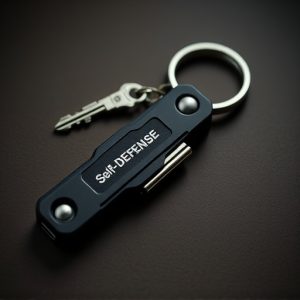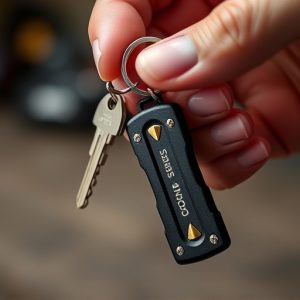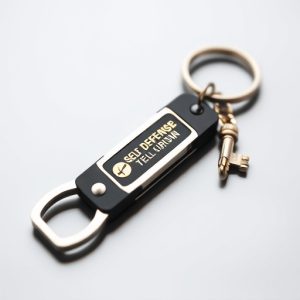Quick Release Keychain Safety Devices: Benefits and Legal Aspects
Non-lethal keychain weapons like pepper spray keychains and stun guns are gaining popularity as pers…….
Non-lethal keychain weapons like pepper spray keychains and stun guns are gaining popularity as personal safety tools worldwide, but their legality varies greatly. These compact devices offer swift deployment of sharp edges or blades through a quick release mechanism, fitting easily into pockets for discreet carry. They are permitted in many public spaces, empowering users with an easy-to-use defense option against unexpected threats. Ensuring the safety and reliability of these weapons under current regulations involves rigorous testing and regular maintenance to meet legal standards, especially in regions where non-lethal keychain weapons are allowed for self-defense.
In today’s world, personal safety is paramount. One innovative solution gaining traction are non-lethal keychain weapons equipped with quick release mechanisms. This article explores the legal perspective of these compact self-defense devices, delving into their design and functionality. We’ll uncover the benefits and diverse applications, from everyday carry to emergency situations. Additionally, we provide testing and maintenance guidelines to ensure reliability, answering key questions for those considering this modern safety option, especially in regions where non-lethal keychain weapons are allowed.
- Understanding Non-Lethal Keychain Weapons: A Legal Perspective
- The Design and Functionality of Quick Release Mechanisms
- Benefits and Applications: Why Choose a Keychain Safety Device?
- Ensuring Safety and Reliability: Testing and Maintenance Guidelines
Understanding Non-Lethal Keychain Weapons: A Legal Perspective
In many jurisdictions, the concept of non-lethal keychain weapons is gaining traction as a viable option for personal safety. These compact and easily concealable devices are designed to incapacitate or deter potential assailants without causing permanent harm. From pepper spray keychains to stun guns, these tools offer individuals added security while they’re on the go. However, navigating the legal landscape surrounding non-lethal keychain weapons is essential.
The legality of carrying such devices varies significantly from country to country and even within different states or regions. Some areas may permit their use only for specific purposes, such as self-defense in extreme situations, while others might restrict them entirely. Understanding these legal frameworks is crucial to ensure compliance and avoid potential consequences. Keychain weapons allowed often come with strict guidelines regarding age restrictions, hidden carry permits, and public safety regulations.
The Design and Functionality of Quick Release Mechanisms
The quick release mechanism on a keychain safety device is a sophisticated yet simple design feature that revolutionizes personal security. This innovation allows for swift deployment, ensuring users can defend themselves in unexpected situations. The mechanism typically involves a lever or button that, when activated, releases a sharp edge or blade stored within the compact keychain. This non-lethal keychain weapon is allowed in many public spaces, offering individuals a sense of empowerment and peace of mind.
Its functionality is key to its effectiveness; it enables users to respond quickly to threats without the need for extensive training. The design often incorporates a sturdy lock that secures the blade until needed, ensuring accidental deployment is impossible. This innovative feature has become a game-changer in personal safety, providing an easy-to-carry and readily available defense option for folks facing dangerous scenarios in today’s bustling world.
Benefits and Applications: Why Choose a Keychain Safety Device?
Keychain safety devices equipped with quick release mechanisms offer a range of benefits, especially in situations where personal security is paramount. One of the primary advantages is their compact size and convenience; these devices can easily fit into pockets or attach to keys, making them readily accessible when needed. This portability ensures that individuals have a non-lethal self-defense option available without drawing unnecessary attention.
The application of such devices is diverse. Whether it’s for personal safety while traveling, hiking, or walking alone, or as a tool for security guards and first responders who require swift access to defense mechanisms, keychain safety devices provide a sense of empowerment. With many regions allowing non-lethal weapons, like pepper spray or tasers, on person for self-defense, these keychain gadgets offer a discrete yet effective solution, ensuring peace of mind in potentially dangerous environments.
Ensuring Safety and Reliability: Testing and Maintenance Guidelines
Ensuring Safety and Reliability: Testing and Maintenance Guidelines
The primary focus of any keychain safety device, including quick release mechanisms, should be on user safety and reliability. It’s crucial to note that non-lethal keychain weapons allowed under current regulations require rigorous testing to guarantee their effectiveness while minimizing risk. This includes dropping tests to simulate various impact scenarios, stress testing for durability, and temperature resistance checks to ensure consistent performance across different environments.
Proper maintenance is equally vital. Regular cleaning and lubrication of the quick release mechanism can prevent friction-related issues and ensure smooth operation. Users should also inspect their devices periodically for any signs of damage or wear, promptly replacing parts if necessary. Following these guidelines will help maintain the integrity of the keychain safety device, ensuring its reliability in critical moments while adhering to legal standards regarding non-lethal weapons.
Keychain safety devices with quick release mechanisms offer a practical and non-lethal option for personal defense, especially in situations where speed and ease of deployment are crucial. As many jurisdictions now allow non-lethal keychain weapons, understanding their design, benefits, and proper maintenance is essential. These compact devices provide users with peace of mind, knowing they can swiftly defend themselves in unexpected encounters. By adhering to safety guidelines and regular testing, individuals can ensure these tools remain reliable, making them valuable additions for those seeking enhanced personal security without the need for lethal force.


